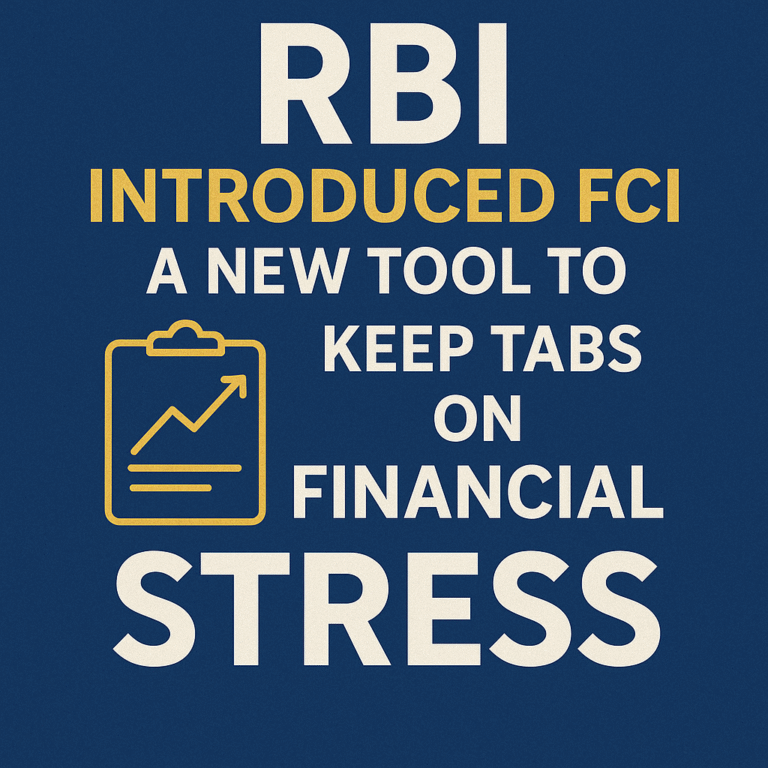In a groundbreaking move, the Reserve Bank of India (RBI) introduced FCI, a new tool to keep tabs on financial stress, marking a transformative shift in how India monitors the health of its financial markets. With growing global uncertainties, currency volatility, and interest rate shifts, the need for a real-time, data-driven stress-tracking mechanism has never been more critical.
The newly launched Financial Conditions Index (FCI) provides a single, composite indicator that reflects the overall ease or tightness of financial conditions in the economy. It combines various metrics like credit spreads, interest rates, liquidity, and stock market volatility into one powerful signal.
As RBI introduced FCI, a new tool to keep tabs on financial stress, it has empowered policymakers, economists, and financial institutions with an early warning system. This development not only aligns India with global central banking practices but also strengthens RBI’s ability to maintain economic stability in times of crisis.
In this blog, we break down 5 key facts you should know about the FCI—what it is, why it matters, and how it impacts students, bankers, and exam aspirants alike.
🔍 5 Key Facts About the RBI’s New FCI Tool
1. What Is the FCI?
The Financial Conditions Index (FCI) is a comprehensive measure that reflects the overall state of financial markets in India. When the RBI introduced FCI, a new tool to keep tabs on financial stress, it aimed to give policymakers, economists, and market participants a quantitative signal of financial stress levels.
This tool combines multiple financial variables into a single composite index, making it easier to monitor macroeconomic risks and take corrective action.
2. Why RBI Introduced FCI, a New Tool to Keep Tabs on Financial Stress
The Reserve Bank of India has long needed a dynamic mechanism to assess real-time market pressures. While inflation, repo rates, and GDP growth offer snapshots of the economy, they don’t tell the whole story.
That’s why RBI introduced FCI, a new tool to keep tabs on financial stress, specifically to:
🔄 Track changes in liquidity and credit flow
⚠️ Detect financial turbulence early (e.g., during global crises)
📊 Improve monetary policy transmission
🛡️ Provide buffers against systemic risks
📉 Ensure smoother flow of credit during economic slowdowns
3. What Indicators Does the FCI Use?
The FCI incorporates data from:
💹 Credit spreads between corporate and government bonds
💰 Liquidity conditions in inter-bank lending markets
📈 Interest rate movements including the repo and reverse repo rates
📉 Market volatility, measured through stock indices like Nifty and the India VIX
These are statistically weighted to generate an accurate picture of stress levels across sectors.
| Component | Description |
|---|---|
| 💰 Liquidity Indicators | Cash reserve ratio (CRR), call money rates, etc. |
| 📉 Credit Spreads | Difference between government bond yields and corporate bond yields |
| 💸 Interest Rates | Repo rate, reverse repo, and inter-bank lending rates |
| 📈 Market Volatility | NSE Nifty, BSE Sensex fluctuations, VIX index |
4. How Will the FCI Be Used?
When the RBI introduced FCI, a new tool to keep tabs on financial stress, it modeled the index on global best practices. A higher FCI score signals tighter financial conditions and possible market stress, while a lower score indicates a more relaxed and accommodative environment.
The RBI uses FCI for:
Assessing policy effectiveness
Evaluating banking system health
Forecasting potential shocks in capital markets
5. Why Is the FCI Important for Students & Competitive Exams?
This development is highly relevant for UPSC, Banking, SSC, and MBA aspirants. It falls under:
Indian Economy
RBI Reforms & Tools
Financial Market Awareness
Current Affairs (July 2025)
🌍 Global Relevance
India joins a list of nations where central banks use similar indices:
🇺🇸 Federal Reserve: Chicago Fed National Financial Conditions Index (NFCI)
🇪🇺 European Central Bank: Euro Area Financial Stress Index
🇨🇦 Bank of Canada: Canadian Financial Stress Index
By introducing FCI, RBI aligns India’s monetary policy tools with international standards.
The launch of FCI brings many benefits:
✅ Early warning for market crashes
✅ Data-driven decision-making for monetary policies
✅ Real-time tracking of financial market liquidity
✅ Improved communication between RBI and commercial banks
As RBI introduced FCI, a new tool to keep tabs on financial stress, it ensures stronger crisis management and predictive economic planning.
📘 FAQ: RBI Introduced FCI, a New Tool to Keep Tabs on Financial Stress
Q1. What does FCI stand for in RBI’s context?
A: Financial Conditions Index
Q2. When did RBI launch the FCI?
A: July 2025
Q3. What indicators are included in the FCI?
A: Liquidity, interest rates, credit spreads, market volatility
Q4. Why did RBI introduce FCI?
A: To track financial stress and improve monetary policy decision-making
Q5. Is FCI unique to India?
A: No, similar indices exist globally (e.g., in the US, EU, Canada)
🎯 Final Thoughts
When the RBI introduced FCI, a new tool to keep tabs on financial stress, it was a strategic leap forward in India’s economic surveillance. With complex financial ecosystems and global interdependencies, traditional metrics alone cannot reveal real-time stress signals. The FCI will help India remain resilient, responsive, and ready for economic fluctuations.
For students, analysts, and financial enthusiasts, the Financial Conditions Index is a must-follow tool that reflects the pulse of the economy—precisely why RBI introduced FCI, a new tool to keep tabs on financial stress in the first place.


One Response